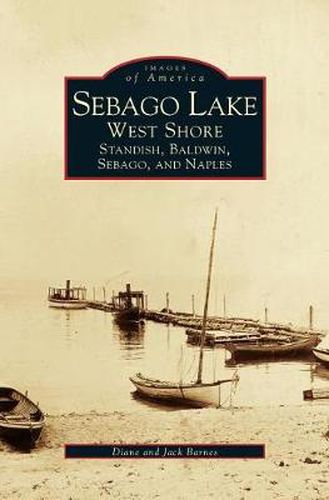Readings Newsletter
Become a Readings Member to make your shopping experience even easier.
Sign in or sign up for free!
You’re not far away from qualifying for FREE standard shipping within Australia
You’ve qualified for FREE standard shipping within Australia
The cart is loading…






This title is printed to order. This book may have been self-published. If so, we cannot guarantee the quality of the content. In the main most books will have gone through the editing process however some may not. We therefore suggest that you be aware of this before ordering this book. If in doubt check either the author or publisher’s details as we are unable to accept any returns unless they are faulty. Please contact us if you have any questions.
The four Cumberland County towns–Standish, Baldwin, Sebago, and Naples–along the west shore of Maine’s second largest freshwater body of water, Sebago Lake, form the core of the latest work by Diane and Jack Barnes: Sebago Lake: West Shore. Even at a time when the vast hinterland of Maine was plagued by raids from Native Americans allied to the French, intrepid woodsmen and settlers ventured into the rugged, primeval wilderness via the Presumpscot and Saco rivers as far as Standish. But by 1830, the Cumberland & Oxford Canal was completed, and the four towns in this volume and several others in the area were linked to Portland and beyond. For the next 40 years, the area was well served by this 17-mile canal. In 1870, the Portland & Ogdensburg Railroad reached the west shore of Sebago Lake. This gave birth to the colorful steamboat era, invited sportsmen, excursionists, and vacationers to flock to the area, and encouraged many enterprising farmers to open their doors to boarders. Hotels, however, soon replaced many of the boarding houses, and a strong tourism industry had begun in earnest. Through precious old photographs and extensive research, Sebago Lake: West Shore chronicles the time of the earliest settlement of Standish, Baldwin, Sebago, and Naples, to the grand hotel era and more recent times. These pages are replete with common and unfamiliar images that combine to regale the history of the west shore.
$9.00 standard shipping within Australia
FREE standard shipping within Australia for orders over $100.00
Express & International shipping calculated at checkout
This title is printed to order. This book may have been self-published. If so, we cannot guarantee the quality of the content. In the main most books will have gone through the editing process however some may not. We therefore suggest that you be aware of this before ordering this book. If in doubt check either the author or publisher’s details as we are unable to accept any returns unless they are faulty. Please contact us if you have any questions.
The four Cumberland County towns–Standish, Baldwin, Sebago, and Naples–along the west shore of Maine’s second largest freshwater body of water, Sebago Lake, form the core of the latest work by Diane and Jack Barnes: Sebago Lake: West Shore. Even at a time when the vast hinterland of Maine was plagued by raids from Native Americans allied to the French, intrepid woodsmen and settlers ventured into the rugged, primeval wilderness via the Presumpscot and Saco rivers as far as Standish. But by 1830, the Cumberland & Oxford Canal was completed, and the four towns in this volume and several others in the area were linked to Portland and beyond. For the next 40 years, the area was well served by this 17-mile canal. In 1870, the Portland & Ogdensburg Railroad reached the west shore of Sebago Lake. This gave birth to the colorful steamboat era, invited sportsmen, excursionists, and vacationers to flock to the area, and encouraged many enterprising farmers to open their doors to boarders. Hotels, however, soon replaced many of the boarding houses, and a strong tourism industry had begun in earnest. Through precious old photographs and extensive research, Sebago Lake: West Shore chronicles the time of the earliest settlement of Standish, Baldwin, Sebago, and Naples, to the grand hotel era and more recent times. These pages are replete with common and unfamiliar images that combine to regale the history of the west shore.